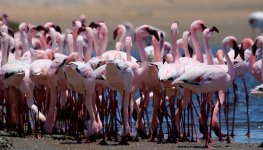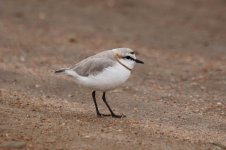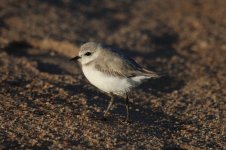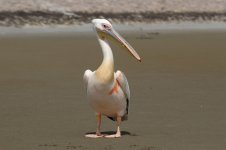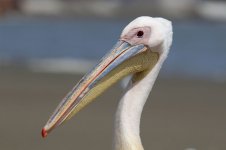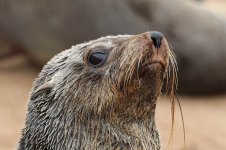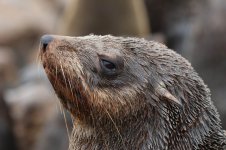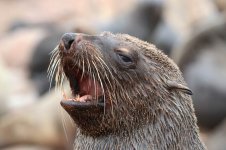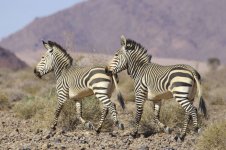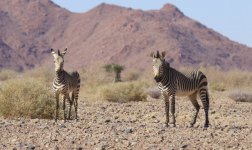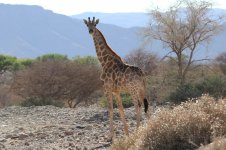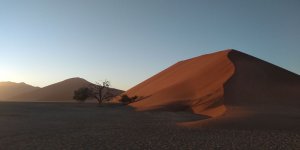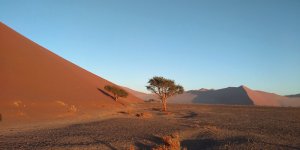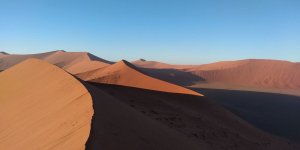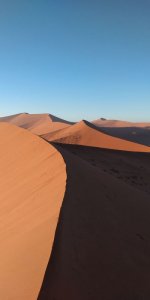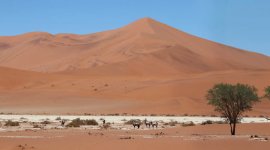-
Welcome to BirdForum, the internet's largest birding community with thousands of members from all over the world. The forums are dedicated to wild birds, birding, binoculars and equipment and all that goes with it.
Please register for an account to take part in the discussions in the forum, post your pictures in the gallery and more.
You are using an out of date browser. It may not display this or other websites correctly.
You should upgrade or use an alternative browser.
You should upgrade or use an alternative browser.
The Great Escape, Namibia. (1 Viewer)
- Thread starter Jos Stratford
- Start date
More options
Who Replied?
A few photographs from earlier in the trip - a brief selection from Walvis Bay for starters
Attachments


A couple of videos from Cape Cross, give a better idea about the sight and sound of this impressive colony

 photos.app.goo.gl
photos.app.goo.gl

 photos.app.goo.gl
photos.app.goo.gl
New video by Lithuania And Beyond
 photos.app.goo.gl
photos.app.goo.gl
New video by Lithuania And Beyond
 photos.app.goo.gl
photos.app.goo.gl

Some mammals on route to Sossusvlei
Attachments

Maroon Jay
Airborne

Thanks Jos. Great photos and information. Namibia is definitely on my list when I feel that it is safe to travel again.

OopsFabulous photos. Are you sure your Bat-eared Fox isn't Cape Fox?

18-20 December. Waterburg Plateau.
Catching considerably more water than the surrounding arid lands, the Waterburg Plateau is a slab of rock 50 km in length, 16 km wide and 200 metres high. As such, rising above the surrounding plains, the plateau serves as an effective rain trap, the result an island of moderate greenery, perennial springs at the base of the plateau supporting relatively lush vegetation.
Day One.
Arrived in the Waterburg area about 10 am, hints of green far more advanced than in the lands we had left behind. And roadside, as well as umpteen Warthog and herds of Impala, quite an impressive showing of butterflies - in damp patches left over from rains in previous days, mass gatherings of whites and blues. Stop one, clouds of Brown-veined Whites generously dotted with Zebra Whites, Common Orange-Tips and African Migrants. To their side, Broad-bordered Grass Yellows and African Monarchs in good numbers, plus quite exquisite Hintza Blues and abundant Velvet-spotted Blues and Common Zebra Blues. Already highly active in the hot sun, quite a bit of effort to track down some of the more elusive species present but did eventually add several Dotted Blues and a couple of Gaika Blues, plus a Lemon Traveller. A few kilometres further, an even bigger conglomeration - talking salts from a rapidly evaporating puddle, again masses of Brown-veined Whites, Velvet-spotted Blues and Hintza Blues, plus two Long-tailed Blues and a Thorntree Blue.
After quite some delay due to butterflies, finally rolled into the grounds of Waterburg Wilderness, a private reserve at the base of the plateau, thick acacia bush home to White Rhinos, Damara Dik-diks and countless birds, the rocky slopes rising to the plateau supporting an entirely new collection of birds. Set up camp at the junction of the plains and rocky escarpment, then drove to upper camp and walked a trail close tobthe escarpment - had hoped for Rockrunner on this open exposed path, but pretty pointless in the heat of the day, (though I did see two African Hawk Eagles overhead). Returning, I took an alternative wooded trail, this proving far better for butterflies - here and in open areas around the camp, truly amazing numbers of butterflies! Heading the list, literally thousands of Brown-veined Whites, but also a very nice selection of extras - among many species, at least 30 Guineafowl butterflies, a couple of Wandering Donkey Acraeas, a Common Dotted Border and two Foxy Emperors. Also on the lawns of the camp, a tribe of Banded Mongeese, a half dozen Warthogs, a massive troop of Baboons and rather many Rock Dassies.
Added Kudu and several Damara Dik-diks en route back. The real treat however was awaiting back at camp - not only a family of Black Mongeese scampering by, but absolutely fantastic views of a Bushveld Elephant-Shrew ... big ears, oversize eyes and a wiggling trunk-like nose, what a classic little beastie!
Day Two.
Fantastic day. Kicked off at dawn with a pair of Verreaux's Eagles patrolling the clifftops, the skies beyond them full of Bradfield's Swifts and Rock Martins, soon after adding flocks of Rosy-faced Lovebirds and Damara Hornbills. And then, as the sun became hot, I once again turned my attention to butterflies - both along the entrance road again and at the upper camp and adjacent trails. Best day of the trip so far on terms of butterflies - a grand total of 25 species seen, including some very fine species, the absolute highlight being an oozing tree that attracted a nice selection of emperors - 12 Foxy Emperors, five Green-veined Emperors, three Demon Emperors and one fantastic Large Blue Emperor! Not bad for birds too - the highlight a Rockrunner that had the good grace to appear during a mid-afternoon break back at camp.
Just after sunset, concluded the day with three exquisite Lesser Bushbabies scampering around a tree. Saw them just in time ...a mother of all storms was already rolling in, thunder echoing around the valley, bolts of lightning illuminating the brooding skies. Made a dash back to camp, rain was now lashing down, the dirt roads soon turning into raging rivers. Piled into the tent, hoped it would hack the onslaught. Fortunately, despite several hours of rain and most of my campsite turning into a lake, all remained mostly dry.
Day Three.
Moderately clear skies at dawn, but mud wash-outs and water everywhere. Walked a 10 km loop through flat acacia woodland, a lot of fairly damp birds clambering atop bushes and trees ... Black-winged Kite, Damara Red-billed Hornbills, Jacobin, Diederik and Red-chested Cuckoos, Pearl-spotted Owlet, Common Scimitarbill, Purple Roller, Acacia Pied Barbets. With the rain, tracks of mammals largely obliterated, but lovely fresh pads of Brown Hyena soon discovered, a large individual plodding along a wet sandy track for a couple of kilometres. Even better, a few kilometres further, fresh tracks of two White Rhinos wandering up a track ... thought I had a good chance of encountering these and followed for a kilometre or so before they departed my trail. Spots of rain again, so quickly nipped back to camp before the heavens once again opened. On return to the rhino trail as the rain once again eased, low and behold the two animals had returned and gone back down the very trail I had just walked up! They could be no more than 45 minutes in front of me, but alas I did not find them, nor a third White Rhino that I also found tracks of. Still, gripping stuff to be walking in the lands of the giants. Despite cloudy skies, still some butterflies out and about - top of the lot, one more Lemon Traveller, a few Yellow Pansies, one Foxy Emperor and a couple of Wandering Donkey Acraeas.
With the rain turning the Kalahari sands into a quagmire, moving my car was no easy task! Uphill was impossible, and downhill seemed pretty likely to result in getting stuck too. Had planned to stay another night, but as dark clouds were threatening further downpours, thought it wise to attempt to get out while relatively dry. An hour of sunshine and temperatures close to 30 C did the trick ...firmed up the road surface just enough to get out, Otjiwarongo bound I was, rain falling again as I cleared the worst stretch of track.
Comfy night in the semi-luxury of the Out of Africa Lodge in Otjiwarongo, shopped up for the next stage of the trip, a week in Etosha.
Catching considerably more water than the surrounding arid lands, the Waterburg Plateau is a slab of rock 50 km in length, 16 km wide and 200 metres high. As such, rising above the surrounding plains, the plateau serves as an effective rain trap, the result an island of moderate greenery, perennial springs at the base of the plateau supporting relatively lush vegetation.
Day One.
Arrived in the Waterburg area about 10 am, hints of green far more advanced than in the lands we had left behind. And roadside, as well as umpteen Warthog and herds of Impala, quite an impressive showing of butterflies - in damp patches left over from rains in previous days, mass gatherings of whites and blues. Stop one, clouds of Brown-veined Whites generously dotted with Zebra Whites, Common Orange-Tips and African Migrants. To their side, Broad-bordered Grass Yellows and African Monarchs in good numbers, plus quite exquisite Hintza Blues and abundant Velvet-spotted Blues and Common Zebra Blues. Already highly active in the hot sun, quite a bit of effort to track down some of the more elusive species present but did eventually add several Dotted Blues and a couple of Gaika Blues, plus a Lemon Traveller. A few kilometres further, an even bigger conglomeration - talking salts from a rapidly evaporating puddle, again masses of Brown-veined Whites, Velvet-spotted Blues and Hintza Blues, plus two Long-tailed Blues and a Thorntree Blue.
After quite some delay due to butterflies, finally rolled into the grounds of Waterburg Wilderness, a private reserve at the base of the plateau, thick acacia bush home to White Rhinos, Damara Dik-diks and countless birds, the rocky slopes rising to the plateau supporting an entirely new collection of birds. Set up camp at the junction of the plains and rocky escarpment, then drove to upper camp and walked a trail close tobthe escarpment - had hoped for Rockrunner on this open exposed path, but pretty pointless in the heat of the day, (though I did see two African Hawk Eagles overhead). Returning, I took an alternative wooded trail, this proving far better for butterflies - here and in open areas around the camp, truly amazing numbers of butterflies! Heading the list, literally thousands of Brown-veined Whites, but also a very nice selection of extras - among many species, at least 30 Guineafowl butterflies, a couple of Wandering Donkey Acraeas, a Common Dotted Border and two Foxy Emperors. Also on the lawns of the camp, a tribe of Banded Mongeese, a half dozen Warthogs, a massive troop of Baboons and rather many Rock Dassies.
Added Kudu and several Damara Dik-diks en route back. The real treat however was awaiting back at camp - not only a family of Black Mongeese scampering by, but absolutely fantastic views of a Bushveld Elephant-Shrew ... big ears, oversize eyes and a wiggling trunk-like nose, what a classic little beastie!
Day Two.
Fantastic day. Kicked off at dawn with a pair of Verreaux's Eagles patrolling the clifftops, the skies beyond them full of Bradfield's Swifts and Rock Martins, soon after adding flocks of Rosy-faced Lovebirds and Damara Hornbills. And then, as the sun became hot, I once again turned my attention to butterflies - both along the entrance road again and at the upper camp and adjacent trails. Best day of the trip so far on terms of butterflies - a grand total of 25 species seen, including some very fine species, the absolute highlight being an oozing tree that attracted a nice selection of emperors - 12 Foxy Emperors, five Green-veined Emperors, three Demon Emperors and one fantastic Large Blue Emperor! Not bad for birds too - the highlight a Rockrunner that had the good grace to appear during a mid-afternoon break back at camp.
Just after sunset, concluded the day with three exquisite Lesser Bushbabies scampering around a tree. Saw them just in time ...a mother of all storms was already rolling in, thunder echoing around the valley, bolts of lightning illuminating the brooding skies. Made a dash back to camp, rain was now lashing down, the dirt roads soon turning into raging rivers. Piled into the tent, hoped it would hack the onslaught. Fortunately, despite several hours of rain and most of my campsite turning into a lake, all remained mostly dry.
Day Three.
Moderately clear skies at dawn, but mud wash-outs and water everywhere. Walked a 10 km loop through flat acacia woodland, a lot of fairly damp birds clambering atop bushes and trees ... Black-winged Kite, Damara Red-billed Hornbills, Jacobin, Diederik and Red-chested Cuckoos, Pearl-spotted Owlet, Common Scimitarbill, Purple Roller, Acacia Pied Barbets. With the rain, tracks of mammals largely obliterated, but lovely fresh pads of Brown Hyena soon discovered, a large individual plodding along a wet sandy track for a couple of kilometres. Even better, a few kilometres further, fresh tracks of two White Rhinos wandering up a track ... thought I had a good chance of encountering these and followed for a kilometre or so before they departed my trail. Spots of rain again, so quickly nipped back to camp before the heavens once again opened. On return to the rhino trail as the rain once again eased, low and behold the two animals had returned and gone back down the very trail I had just walked up! They could be no more than 45 minutes in front of me, but alas I did not find them, nor a third White Rhino that I also found tracks of. Still, gripping stuff to be walking in the lands of the giants. Despite cloudy skies, still some butterflies out and about - top of the lot, one more Lemon Traveller, a few Yellow Pansies, one Foxy Emperor and a couple of Wandering Donkey Acraeas.
With the rain turning the Kalahari sands into a quagmire, moving my car was no easy task! Uphill was impossible, and downhill seemed pretty likely to result in getting stuck too. Had planned to stay another night, but as dark clouds were threatening further downpours, thought it wise to attempt to get out while relatively dry. An hour of sunshine and temperatures close to 30 C did the trick ...firmed up the road surface just enough to get out, Otjiwarongo bound I was, rain falling again as I cleared the worst stretch of track.
Comfy night in the semi-luxury of the Out of Africa Lodge in Otjiwarongo, shopped up for the next stage of the trip, a week in Etosha.

Need to update this a bit....

Etosha. 21-28 December.
Spanning 23,000 km² around the gleaming white salts of Etosha Pan, this is truly one of the top wildlife areas in Africa. Baking under a relentless sun and temperatures of close to 40 C, I spent an excellent week here, fortunately coinciding with the very beginning of the rainy season - a fresh green flush, heaps of babies being born.
Day One. 21 December.
Drove up from Otjiwarongo, entered Etosha about 10.00 am, first mammals a bunch of Banded Mongoose crossing the access track. In the hot dry savanna landscapes of the central part of Etosha, set up camp in Okaukuejo, nests of Sociable Weavers in the acacias above, Ground Squirrels checking out our tents, Springbok and Zebra plodding their way to the adjacent waterhole. A couple of hours chasing butterflies around camp, temperature sitting way up at 38 C, then our first proper exploration of Etosha. Looped eastward via Gemsbokvlakte, large flocks of both Grey-backed Sparrow-Larks and Chestnut-backed Sparrow-Larks, lots of Southern Black Korhaans and Red-crested Korhaans, one Ludwig's Bustard too, plus a range of other birds including a hissing pair of Spotted Thick-knees guarding their nest. No shortage of mammals either, ever present Black-faced Impala and Zebras, a few Giraffe and a number of Wildebeest and Kudu among the early ones. And then our first predators - panting in the heat, lounging in the shade of two adjacent acacias, one splendid pride of Lions, one full mane male, one younger male, five females. After a half hour with these fine felines, with their activity in the heat limited to casual glances our way and occasional relocations beneath the bushes, we decided to head on. Looped down towards the edge of the vast salt pan, two Spotted Hyena en route, plus a freshly dead Lion not too far away, a rather thin looking individual. Leaving this rather sad sight, headed back towards Okaukuejo camp, where yet more luck with a Black Rhino just outside camp grazing acacia bushes alongside the track, then up to up to Okondeka for sunset. In a particularly arid area, Okondeka is a natural water spring emerging right on the edge of the stark white of the salt flats. Out there, merging into a mirage of water, shimmering shapes of Ostriches and a single Wildebeest. At the waterhole itself, Gemsbok, Springbok and a Black-backed Jackal. However, just to the rear, under the only trees for kilometres, a familiar sight - never have I been to Okandeka without finding Lions residing beneath thoae trees. And indeed, there there were again, our second pride of Lions of the day, this time one full mane male, again a younger male and three females. Not happy looking Lions it has to be said, this being the very end of the long dry season, these looked the worse for wear - very thin, no sleekness, drawn looking faces, hard times at Okandeka.
And then it was time to return to camp, gates closing as the sun went down. One very welcome Honey Badger on route back. Top class cooking on the fire (noodles and tea), then a short wander over to the waterhole. One of the true attractions of Etosha, Okandeka waterhole is situated right against the camp, a rather low and rickety fence all that separates you from the abundance of mammals that visit. Endless Zebra and antelopes of various sorts during the day, then an amazing array during the night, the waterhole floodlit. And what a spectacle it is, first hundreds of Double-banded Sandgrouse descend to drink, then the scores of nightjars begin to hawk, Freckled and Rufous-cheeked Nightjars in the main, I think several European Nightjars too. And the piece de la resistance of the waterhole, Black Rhinos! Showing periodic argy bargy, an impressive eight Black Rhinos were gathered within an hour, some simply standing in the water shallows, others having nose to nose love ins. Several Giraffes too, an occasional Black-backed Jackal and, creating a little pandemonium at the waterhole, one herd of 12 Elephants, a couple of newborns in tow. What with a Fork-tailed Drongo taking advantage of the spotlights for a bit of nocturnal hunting and a Spotted Eagle Owl swooping in, not a bad evening in all.
Spanning 23,000 km² around the gleaming white salts of Etosha Pan, this is truly one of the top wildlife areas in Africa. Baking under a relentless sun and temperatures of close to 40 C, I spent an excellent week here, fortunately coinciding with the very beginning of the rainy season - a fresh green flush, heaps of babies being born.
Day One. 21 December.
Drove up from Otjiwarongo, entered Etosha about 10.00 am, first mammals a bunch of Banded Mongoose crossing the access track. In the hot dry savanna landscapes of the central part of Etosha, set up camp in Okaukuejo, nests of Sociable Weavers in the acacias above, Ground Squirrels checking out our tents, Springbok and Zebra plodding their way to the adjacent waterhole. A couple of hours chasing butterflies around camp, temperature sitting way up at 38 C, then our first proper exploration of Etosha. Looped eastward via Gemsbokvlakte, large flocks of both Grey-backed Sparrow-Larks and Chestnut-backed Sparrow-Larks, lots of Southern Black Korhaans and Red-crested Korhaans, one Ludwig's Bustard too, plus a range of other birds including a hissing pair of Spotted Thick-knees guarding their nest. No shortage of mammals either, ever present Black-faced Impala and Zebras, a few Giraffe and a number of Wildebeest and Kudu among the early ones. And then our first predators - panting in the heat, lounging in the shade of two adjacent acacias, one splendid pride of Lions, one full mane male, one younger male, five females. After a half hour with these fine felines, with their activity in the heat limited to casual glances our way and occasional relocations beneath the bushes, we decided to head on. Looped down towards the edge of the vast salt pan, two Spotted Hyena en route, plus a freshly dead Lion not too far away, a rather thin looking individual. Leaving this rather sad sight, headed back towards Okaukuejo camp, where yet more luck with a Black Rhino just outside camp grazing acacia bushes alongside the track, then up to up to Okondeka for sunset. In a particularly arid area, Okondeka is a natural water spring emerging right on the edge of the stark white of the salt flats. Out there, merging into a mirage of water, shimmering shapes of Ostriches and a single Wildebeest. At the waterhole itself, Gemsbok, Springbok and a Black-backed Jackal. However, just to the rear, under the only trees for kilometres, a familiar sight - never have I been to Okandeka without finding Lions residing beneath thoae trees. And indeed, there there were again, our second pride of Lions of the day, this time one full mane male, again a younger male and three females. Not happy looking Lions it has to be said, this being the very end of the long dry season, these looked the worse for wear - very thin, no sleekness, drawn looking faces, hard times at Okandeka.
And then it was time to return to camp, gates closing as the sun went down. One very welcome Honey Badger on route back. Top class cooking on the fire (noodles and tea), then a short wander over to the waterhole. One of the true attractions of Etosha, Okandeka waterhole is situated right against the camp, a rather low and rickety fence all that separates you from the abundance of mammals that visit. Endless Zebra and antelopes of various sorts during the day, then an amazing array during the night, the waterhole floodlit. And what a spectacle it is, first hundreds of Double-banded Sandgrouse descend to drink, then the scores of nightjars begin to hawk, Freckled and Rufous-cheeked Nightjars in the main, I think several European Nightjars too. And the piece de la resistance of the waterhole, Black Rhinos! Showing periodic argy bargy, an impressive eight Black Rhinos were gathered within an hour, some simply standing in the water shallows, others having nose to nose love ins. Several Giraffes too, an occasional Black-backed Jackal and, creating a little pandemonium at the waterhole, one herd of 12 Elephants, a couple of newborns in tow. What with a Fork-tailed Drongo taking advantage of the spotlights for a bit of nocturnal hunting and a Spotted Eagle Owl swooping in, not a bad evening in all.
Last edited:

My excuse is that I'm still in Namibia and the birding takes precedenceYeah, it's been awhile

Day Two. 22 December.
Woken at 4.00 am by Lions passing by, the deep throaty roars penetrating out from the darkness, most magical. An hour later, they passed by again, still in mighty voice! Decided to get up this time ...and good job I did, not only were the two Lions my temporary neighbours, but so too a very fine Barn Owl in an acacia next to my tent.
With dawn only an hour away, crashed around making coffee for a while, then readied for another day in Etosha. Campsite gates opened at 6.15, out we went. First mammal of the day, Black Rhino, quite happy with that! Plan for this morning was a loop east of Okaukuejo, taking in a number of waterholes and meandering tracks along Etosha Pan. Herds of Springbok, Zebra et al on route, plus yet another two Black Rhinos. Pretty good bird selection too, not least many flocks of Namaqua Sandgrouse dropping in to drink, plus several Kori Bustards, a Martial Eagle, a Wahlsberg's Eagle and the usual masses of finches at waterholes. Cloudless sky, already over 30 C by 10.00 am, clearly a scorching day ahead. Decided to meander back towards camp, passing en route the corpse of the Lion found dead the day before, quite a sight awaiting - gone the untouched body, in its place a heap of ragged remains now in the possession of Spotted Hyenas and a Black-backed Jackal. With two Lappet-faced Vultures and a couple of dozen White-backed Vultures also present, not much of this unfortunate Lion remained intact!
Back at camp, as temperatures reached 37C, many butterflies on the wing. Among the dozen species flying, plenty of Velvet-spotted Blues and Brown-veined Whites as usual, plus several Spotted Jokers, a few Common Diadoms, one Foxy Emperor and, new for the trip, a good number of Topaz Arabs. In reality though, too hot for seeking butterflies - all were hyper active, all very rarely stopped and all virtually impossible to photograph.
Late afternoon to evening, took a drive to the grassland plains west of Okaukuejo. Not very productive, waterholes were all dry, grasses long ago withered and animals very sparsely distributed. On top of that, it stayed 36-37 C right to sunset! Still, managed to encounter one more pride of Lions, all zonked out under a tree, plus a fourth Black Rhino of the day. Got back to camp at sunset, thoughts of another evening at the floodlit waterhole prominent. But what a contrast - whereas there had been Black Rhino present from sundown the night before, not a single Black Rhino appeared before 10 pm this night, and even then only five by 11 pm. No elephants either. Did have a nice Scorpian however, plus a rather nice Barn Owl sitting just adjacent.
Woken at 4.00 am by Lions passing by, the deep throaty roars penetrating out from the darkness, most magical. An hour later, they passed by again, still in mighty voice! Decided to get up this time ...and good job I did, not only were the two Lions my temporary neighbours, but so too a very fine Barn Owl in an acacia next to my tent.
With dawn only an hour away, crashed around making coffee for a while, then readied for another day in Etosha. Campsite gates opened at 6.15, out we went. First mammal of the day, Black Rhino, quite happy with that! Plan for this morning was a loop east of Okaukuejo, taking in a number of waterholes and meandering tracks along Etosha Pan. Herds of Springbok, Zebra et al on route, plus yet another two Black Rhinos. Pretty good bird selection too, not least many flocks of Namaqua Sandgrouse dropping in to drink, plus several Kori Bustards, a Martial Eagle, a Wahlsberg's Eagle and the usual masses of finches at waterholes. Cloudless sky, already over 30 C by 10.00 am, clearly a scorching day ahead. Decided to meander back towards camp, passing en route the corpse of the Lion found dead the day before, quite a sight awaiting - gone the untouched body, in its place a heap of ragged remains now in the possession of Spotted Hyenas and a Black-backed Jackal. With two Lappet-faced Vultures and a couple of dozen White-backed Vultures also present, not much of this unfortunate Lion remained intact!
Back at camp, as temperatures reached 37C, many butterflies on the wing. Among the dozen species flying, plenty of Velvet-spotted Blues and Brown-veined Whites as usual, plus several Spotted Jokers, a few Common Diadoms, one Foxy Emperor and, new for the trip, a good number of Topaz Arabs. In reality though, too hot for seeking butterflies - all were hyper active, all very rarely stopped and all virtually impossible to photograph.
Late afternoon to evening, took a drive to the grassland plains west of Okaukuejo. Not very productive, waterholes were all dry, grasses long ago withered and animals very sparsely distributed. On top of that, it stayed 36-37 C right to sunset! Still, managed to encounter one more pride of Lions, all zonked out under a tree, plus a fourth Black Rhino of the day. Got back to camp at sunset, thoughts of another evening at the floodlit waterhole prominent. But what a contrast - whereas there had been Black Rhino present from sundown the night before, not a single Black Rhino appeared before 10 pm this night, and even then only five by 11 pm. No elephants either. Did have a nice Scorpian however, plus a rather nice Barn Owl sitting just adjacent.

Woken at 4.00 am by Lions passing by, the deep throaty roars penetrating out from the darkness, most magical. An hour later, they passed by again, still in mighty voice!
I think I'd be afraid to leave my room under those circumstances.
foresttwitcher
Virtually unknown member

It may be apocryphal but when I stayed at Okaukuejo in the 90's there was a story that a guest had decided to sleep in the outside B-B-Q area immediately in front of the entrance to his 'hut' and had been killed / taken by a Lion. It certainly kept me inside in the hours of darkness so possibly just a tale by the staff to keep the guests from wandering around too much late at night.
Users who are viewing this thread
Total: 2 (members: 0, guests: 2)






